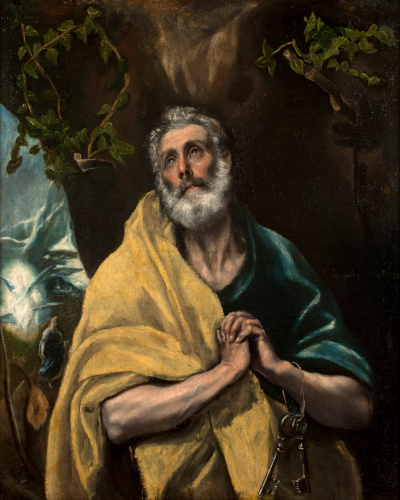The tears of Saint Peter - An expression in pure humillity.
It is a painting symbolising betrayal, regret and remorse. It tells a story of a disciple betraying his master and more so, a friend betraying the deepest of friends. For appreicators of art, the Tears of Saint Peter is a symbol of all the elements of regret, humility and remorse that define people as a whole.
Painted in 1585 by Domenikos Theotokopoulos, a Greek artist who would affectionately come to be known as "El Greco" (The Greek). He began his early career at the age of twenty-six when he moved to Venice and then Rome where he would come to mix his own styles with those of the Venetian Renaissance and the concepts of Mannerism. These ideals would come to show paintings that were asymmetrical and unnaturally elegant. Upon moving to the Spanish city of Toldeo in 1577, El Greco would become famous for a variiety of notable works which included: El Expolio (1577-79), the burial of the Count of Orgaz (1586-88), the view of Toledo (1596-1600) and the opening of the fifth seal (1608-1614).
The painting is known as a defining image used by advocates of the counter-reformation movement to show the humanity of all the Saints, including that of Saint Peter. As a painting, El Greco created it for private viewings with the goal of creating and deep and personal link between the follower and the image. The painting contains a number of features that are defining and visible to viewers. The most important of these elements is the eyes, the windows of the soul. They express a regret and deep sadness for his actions in the denying and betrayal of Jesus during the passion.
It shows him appealing diretly to God and heaven for his actions. It also shows a number of key symbols that reflect not only Peter's role to Jesus but his subsequent position as God's representative on earth. To this end, the picture shows a number of key symbols and characteristics that help identify who Saint Peter was and how he is portrayed within the Christian religion. The first symbol in this regard is the keys that we wears on his left hand side. They symbolise the keys of the Holy Sea and effectively the keys to the Kingdom of Heaven.
Beyond, this is the physical characteristics which identify Saint Peter. The grey hair shows him as someone who is wise and mature whilst his physical characteristics shows someone who is strong and confident; an image widely desired by Christians during this era. The painting also has a number of ordered elements which reflect not only on the character of Peter but the Christian faith. From the painting of the trees, to Saint Peter's act of Prayer, there is a structual elegance present which brings out an ordered beauty within the work.
Overall, the painting can be seen as one of the more humane pictures of El Greco. It shows the flaws of the man who though he loved Jesus will all of his heart, would through weakness of character deny him. Yet in this humility it shos the human face of one of the most important characters of the Christian faith, one would would lay the foundations of the modern church for centuries to come. For those wishing to view the painting today, it can be seen at the El Greco Museum which is located in Toledo.





